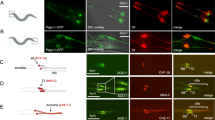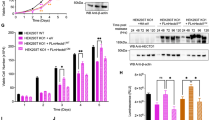Abstract
Chfr is a checkpoint protein that plays an important function in cell cycle progression and tumor suppression, although its exact role and regulation are unclear. Previous studies have utilized overexpression of Chfr to determine the signaling pathway of this protein in vivo. In this study, we demonstrate, by using three different antibodies against Chfr, that the endogenous and highly overexpressed ectopic Chfr protein is localized and regulated differently in cells. Endogenous and lowly expressed ectopic Chfr are cytoplasmic and localize to the spindle during mitosis. Higher expression of ectopic Chfr correlates with a shift in the localization of this protein to the nucleus/PML bodies, and with a block of cell proliferation. In addition, endogenous and lowly expressed ectopic Chfr is stable throughout the cell cycle, whereas when highly expressed, ectopic Chfr is actively degraded during S–G2/M phases in an autoubiquitination and proteasome-dependent manner. A two-hybrid screen identified TCTP as a possible Chfr-interacting partner. Biochemical analysis with the endogenous proteins confirmed this interaction and identified β-tubulin as an additional partner for Chfr, supporting the mitotic spindle localization of Chfr. The Chfr–TCTP interaction was stable throughout the cell cycle, but it could be diminished by the complete depolymerization of the microtubules, providing a possible mechanism where Chfr could be the sensor that detects microtubule disruption and then activates the prophase checkpoint.
This is a preview of subscription content, access via your institution
Access options
Subscribe to this journal
Receive 50 print issues and online access
$259.00 per year
only $5.18 per issue
Buy this article
- Purchase on Springer Link
- Instant access to full article PDF
Prices may be subject to local taxes which are calculated during checkout







Similar content being viewed by others
References
Abrieu A, Magnaghi-Jaulin L, Kahana J, Peter M, Castro A, Vigneron S et al. (2001). Mps1 is a kinetochore-associated kinase essential for the vertebrate mitotic checkpoint. Cell 106: 83–93.
Bothos J, Summers M, Venere M, Scolnick D, Halazonetis T . (2003). The Chfr mitotic checkpoint protein functions with Ubc13–Mms2 to form Lys63-linked polyubiquitin chains. Oncogene 22: 7101–7107.
Burgess A, Wigan M, Giles N, Depinto W, Gillespie P, Stevens F et al. (2006). Inhibition of S/G2 phase CDK4 reduces mitotic fidelity. J Biol Chem 281: 9987–9995.
Chaturvedi P, Sudakin V, Bobiak M, Fisher P, Mattern M, Jablonski S et al. (2002). Chfr regulates a mitotic stress pathway through its RING-finger domain with ubiquitin ligase activity. Cancer Res 62: 1797–1801.
Cheung H, Toyota M, Ching Y, Sasaki Y, Nicholls J, Satoh A et al. (2003). Epigenetic inactivation of CHFR in human tumors. Proc Natl Acad Sci USA 100: 7818–7823.
Corn P, Summers M, Fogt F, Virmani A, Gazdar A, Halazonetis T et al. (2003). Frequent hypermethylation of the 5′ CpG island of the mitotic stress checkpoint gene Chfr in colorectal and non-small cell lung cancer. Carcinogenesis 24: 47–51.
Daniels M, Marson A, Venkitaraman A . (2004). PML bodies control the nuclear dynamics and function of the CHFR mitotic checkpoint protein. Nat Struct Mol Biol 11: 1114–1121.
Erson A, Petty E . (2003). CHFR-associated early G2/M checkpoint defects in breast cancer cells. Mol Carcinog 39: 26–33.
Fromont-Racine M, Rain JC, Legrain P . (1997). Toward a functional analysis of the yeast genome through exhaustive two-hybrid screens. Nat Genet 16: 277–282.
Gabrielli B, De Souza C, Tonks I, Clark J, Hayward N, Ellem K . (1996). Cytoplasmic accumulation of cdc25B phosphatase in mitosis triggers centrosomal microtubule nucleation in HeLa cells. J Cell Sci 109 (Part 5): 1081–1093.
Gachet Y, Tournier S, Lee M, Lazaris-Karatzas A, Poulton T, Bommer U . (1999). The growth-related, translationally controlled protein P23 has properties of a tubulin binding protein and associates transiently with microtubules during the cell cycle. J Cell Sci 112 (Part 8): 1257–1271.
Hsu Y, Chern J, Cai Y, Liu M, Choi K . (2007). Drosophila TCTP is essential for growth and proliferation through regulation of dRheb GTPase. Nature 445: 785–788.
Jung J, Kim M, Kim M, Kim J, Moon J, Lim J et al. (2004). Translationally controlled tumor protein interacts with the third cytoplasmic domain of Na,K-ATPase alpha subunit and inhibits the pump activity in HeLa cells. J Biol Chem 279: 49868–49875.
Kang D, Chen J, Wong J, Fang G . (2002). The checkpoint protein Chfr is a ligase that ubiquitinates Plk1 and inhibits Cdc2 at the G2 to M transition. J Cell Biol 156: 249–259.
Liu H, Peng H, Cheng Y, Yuan H, Yang-Yen H . (2005). Stabilization and enhancement of the antiapoptotic activity of mcl-1 by TCTP. Mol Cell Biol 25: 3117–3126.
Loring GL, Christensen KC, Gerber SA, Brenner C . (2008). Yeast Chfr homologs retard cell cycle at G1 and G2/M via Ubc4 and Ubc13/Mms2-dependent ubiquitination. Cell Cycle 7: 96–105.
Mariatos G, Bothos J, Zacharatos P, Summers M, Scolnick D, Kittas C et al (2003). Inactivating mutations targeting the chfr mitotic checkpoint gene in human lung cancer. Cancer Res 63: 7185–7189.
Matsusaka T, Pines J . (2004). Chfr acts with the p38 stress kinases to block entry to mitosis in mammalian cells. J Cell Biol 166: 507–516.
Mikhailov A, Shinohara M, Rieder C . (2004). The p38-mediated stress-activated checkpoint. A rapid response system for delaying progression through antephase and entry into mitosis. Cell Cycle 4: 57–62.
Mizuno K, Osada H, Konishi H, Tatematsu Y, Yatabe Y, Mitsudomi T et al. (2002). Aberrant hypermethylation of the CHFR prophase checkpoint gene in human lung cancers. Oncogene 21: 2328–2333.
Murray AW, Kirschner MW . (1991). What controls the cell cycle? Sci Am 264: 56–63.
Privette L, González M, Ding L, Kleer C, Petty E . (2007). Altered expression of the early mitotic checkpoint protein, CHFR, in breast cancers: implications for tumor suppression. Cancer Res 67: 6064–6074.
Rieder C, Cole R . (2000). Microtubule disassembly delays the G2–M transition in vertebrates. Curr Biol 10: 1067–1070.
Satoh A, Satoh A, Toyota M, Toyota M, Itoh F, Itoh F et al. (2003). Epigenetic inactivation of CHFR and sensitivity to microtubule inhibitors in gastric cancer. Cancer Res 63: 8606–8613.
Scolnick D, Halazonetis T . (2000). Chfr defines a mitotic stress checkpoint that delays entry into metaphase. Nature 406: 430–435.
Tuynder M, Fiucci G, Prieur S, Lespagnol A, Géant A, Beaucourt S et al. (2004). Translationally controlled tumor protein is a target of tumor reversion. Proc Natl Acad Sci USA 101: 15364–15369.
Tuynder M, Susini L, Prieur S, Besse S, Fiucci G, Amson R et al. (2002). Biological models and genes of tumor reversion: cellular reprogramming through tpt1/TCTP and SIAH-1. Proc Natl Acad Sci USA 99: 14976–14981.
Uzbekov R, Chartrain I, Philippe M, Arlot-Bonnemains Y . (1998). Cell cycle analysis and synchronization of the Xenopus cell line XL2. EMBO Rep 242: 60–68.
Yang Y, Yang F, Xiong Z, Yan Y, Wang X, Nishino M et al. (2005). An N-terminal region of translationally controlled tumor protein is required for its antiapoptotic activity. Oncogene 24: 4778–4788.
Yarm F . (2002). Plk phosphorylation regulates the microtubule-stabilizing protein TCTP. Mol Cell Biol 22: 6209–6221.
Yu X, Minter-Dykhouse K, Malureanu L, Zhao W, Zhang D, Merkle C et al. (2005). Chfr is required for tumor suppression and aurora a regulation. Nat Genet 37: 401–406.
Acknowledgements
We thank Julian Cau from the Montpellier RIO Imaging facility (CRBM). We also acknowledge J Casanova, JM Donnay and JC Mazur for their technical support. This work was supported by the Ligue Nationale Contre le Cancer (Equipe Labellisée). AB is a Ligue Nationale Contre le Cancer fellow.
Author information
Authors and Affiliations
Corresponding authors
Additional information
Supplementary Information accompanies the paper on the Oncogene website (http://www.nature.com/onc)
Rights and permissions
About this article
Cite this article
Burgess, A., Labbé, JC., Vigneron, S. et al. Chfr interacts and colocalizes with TCTP to the mitotic spindle. Oncogene 27, 5554–5566 (2008). https://doi.org/10.1038/onc.2008.167
Received:
Revised:
Accepted:
Published:
Issue Date:
DOI: https://doi.org/10.1038/onc.2008.167



